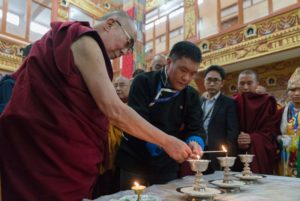
Monday, 24 April 2017
Molly Lortie, Tibet Post International
Dharamshala — Following His Holiness the Dalai Lama’s trip to the contested territory, Arunachal Pradesh, and accusations from China that India has violated its commitments and put border dispute settlements at risk, the Indian government has made assertions that there is no change in policy regarding the Tibet Autonomous Region or border disputes with China.
According to media reports, the External Affairs Ministry spokesperson Gopal Baglay said this week, “Let me make it absolutely clear that there is no change whatsoever in the Government of India’s policy towards the Tibet Autonomous Region of the People’s Republic of China.
“Similarly, our approach to seeking a fair, reasonable and mutually acceptable solution to the boundary question remains unchanged,” a response which followed a question regarding His Holiness the Dalai Lama’s trip to Arunachal and the accusations from China saying that India is violating its commitment on the Tibet issue. China had warned India that allowing the Dalai Lama to go there will have “negative impact” on the settlement of the border dispute.
India continued attempts to prove its good intentions with China, as Congress has issued statements slamming Arunachal Chief Minister Pema Khandu and his “immature and uncalled for” alleged claims that Arunachal borders Tibet and not China.
Khandu had said: “Let me get this straight. China has no business telling us what to do and what not to do because it is not our next-door neighbor.” He further went on to claim that the demarcation of the McMahon Line is between India and Tibet, not China.
State Congress President Takam Sanjoy said in response, “The Chief Minister of a sensitive state like Arunachal Pradesh should not make any statement before going through the political status and history of Tibet, as recognized by the Indian government.”
Sanjoy, a former Lok Sabha member, said Tibet as of today has the status of the ‘Tibet Autonomous Region of People’s Republic of China’.
On April 14, the government in New Delhi said there is no change in the Indian position that Tibet is a part of China and that it will continue to seek a mutually acceptable solution to the boundary issue.
China, since His Holiness’s visit to Arunachal, has released standardized names of six towns in Arunachal in Mandarin Chinese and Tibetan languages in an apparent attempt to legitimize its claim over what it regards as “South Tibet.”
The ministry of civil affairs in Beijing issued an order on April 14 saying that, “The official names of the six places using the Roman alphabet are Wo’gyainling, Mila Ri, Qoidengarbo Ri, Mainquka, Bumo La and Namkapub Ri.” It did not give the existing names of the six towns in Arunachal Pradesh.
The ministry tried to explain that it was a routine administrative work and part of an ongoing census on names of localities. But a Chinese expert, Xiong Kunxin, a professor of ethnic studies at the Minzu University of China in Beijing, contradicted the foreign ministry saying that the renaming exercise was aimed to “reaffirm Chinese sovereignty” over the area that is controlled by India.
Tibet was invaded by the Communist regime in China, starting in 1949. Since that time, over 1.2 million out of 6 Tibetans have been killed, over 6000 monastaries have been destroyed— Crimes against Humanity and Genocide include murder, massacres, torture, rape, starvation, extreme deprivation, forced marches, enslavement, brutal violence, and systematic extermination. Beijing continues to call this a ‘peaceful liberation’, that the “Tibetans are living in a Maoist socialist paradise.”
Tibet was traditionally comprised of three main areas— U-tsang, Kham and Amdo provinces, covers an area of 870,000 square miles. After the occupation of Tibet, other Tibetan areas (Amdo and Kham) were eventually renamed and incorporated into Chinese provinces of Gansu, Qinghai, Sichuan, and Yunnan.
Tibet is located to the south-west of China, also bordering India, Nepal, Burma and Bhutan. Tibet’s historical territory would make it the world’s 10th largest nation. When the communist regime in China refers to Tibet, it means only part of historic Tibet: what it names the “Tibet Autonomous Region” (TAR) of China. The current TAR was eventually established in 1965.
Last Updated ( Monday, 24 April 2017)
